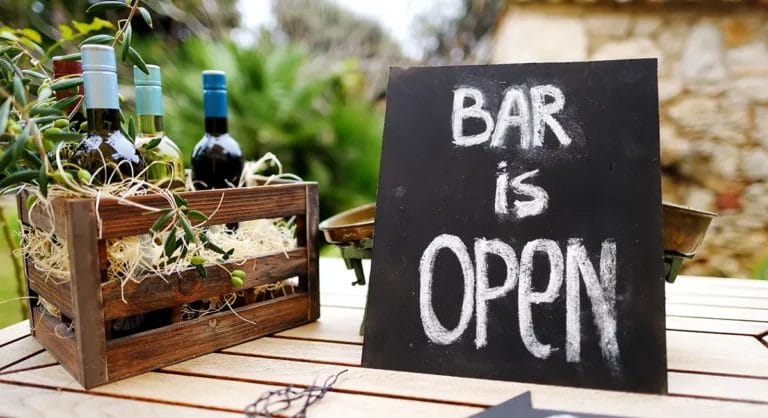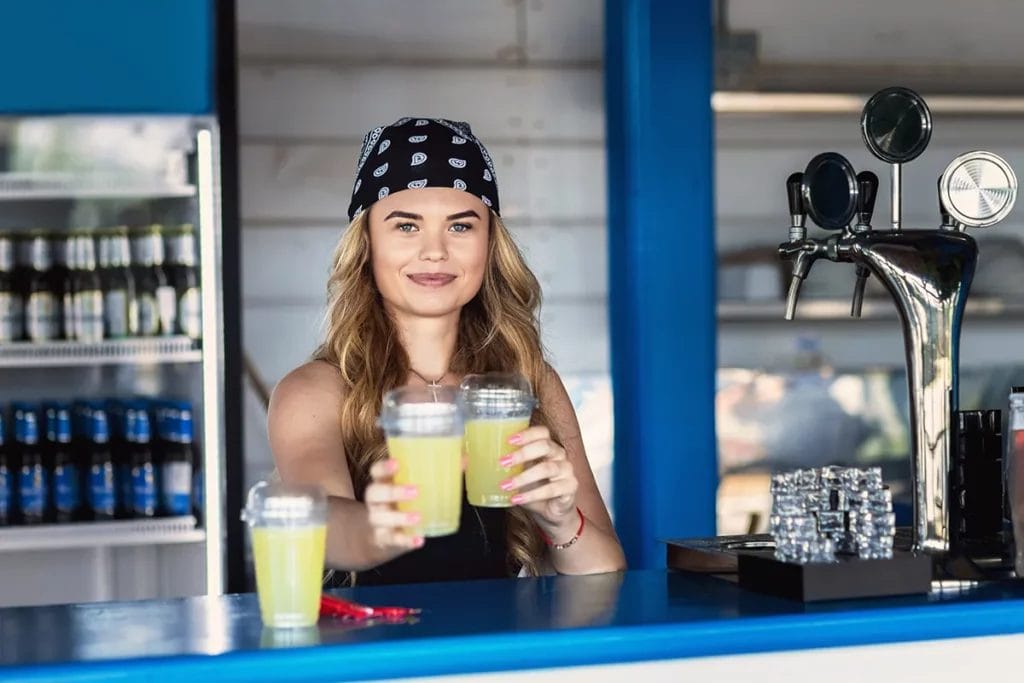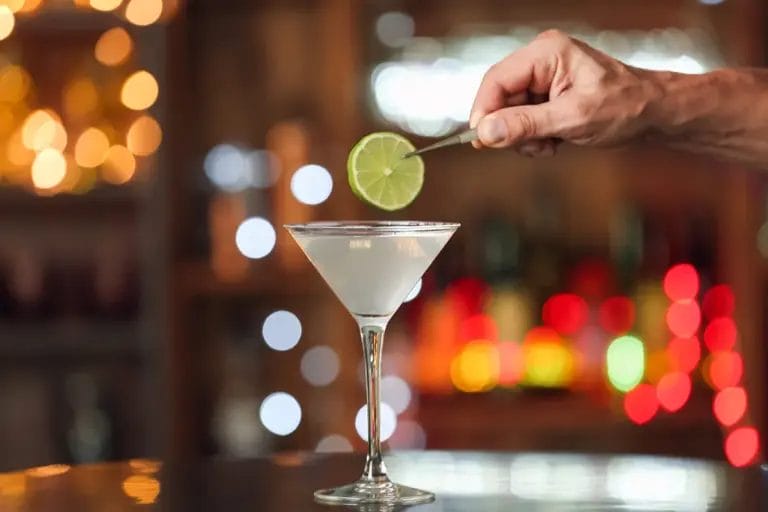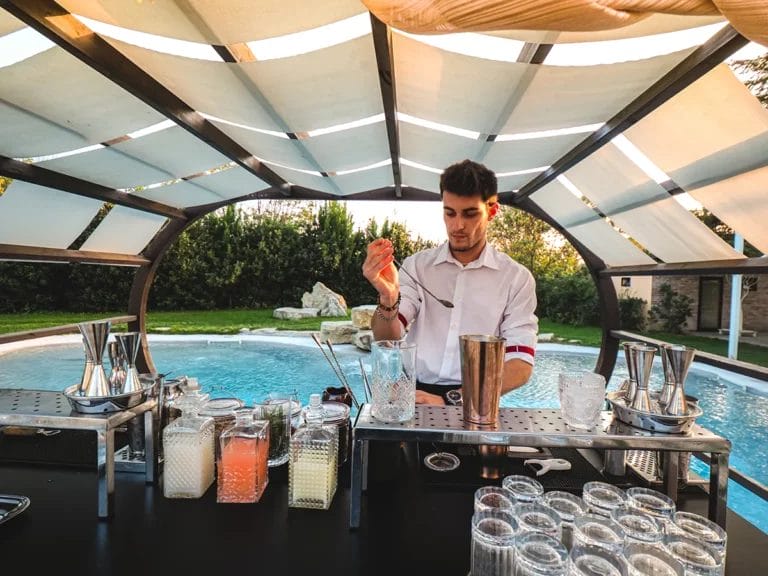Starting a mobile bartender business begins with a solid business plan. Download your free copy of our mobile bartending business plan template today and fill it out as you read each section below!
1. Draft Your Business Plan
Did you know 45% of businesses fail by their fifth year? A lack of planning is one of the biggest reasons these businesses don’t make it.
Don’t let that figure scare you — let it motivate you to put together a detailed, thorough bartender business plan.
Business plans are as much for your sake as they are for investors or banks who ask to see yours before providing loans or funding. Treat it like a road map to keep your mobile bartender business on the path to success.
Business plans should always include the following information:
- Executive summary: A brief, exciting description of your business, including which services you provide, your mission statement, where you operate, and what types of events you want to book
- Company description: More in-depth than your executive summary, this section should include information about your branding, your menu and prices, your team (if you have one), and your business’ legal structure
- Market analysis: An analysis of your target customer, competitors, and location
- Marketing strategy: How you promote your business to attract and retain clients
- Financing: What sources of funding you have (personal funds, loans, grants, etc.)
- Operational costs and financial projections: Your cost of goods sold and operating expenses, as well as where you project your revenue in a year’s time
- Certificate of Insurance (COI): Proof that you have mobile bartending liability insurance
2. Conduct Market Research
Competitor Analysis
You know the phrase “know your enemy”? It doesn’t have to be that intense, but getting to know the competition in your area is key to learning from their successes and failures, as well as setting yourself apart.
- Who are your competitors?
- What services do your competitors offer?
- How do they price their menu/services?
- What do their customers say about them in reviews?
- What are their greatest strengths and weaknesses?
Target Customer
To provide your customers with the service they need, you must understand some basic aspects of who they are.
- What are their demographics (age, income, location, etc.)?
- What problems/pain points do they have?
- What kinds of events are they hosting?
Location Analysis
While mobile bartenders aren’t limited to one location, you’ll have a region or geographic area you operate in. Like your customers and competitors, getting to know this area is key to success.
- Is the market saturated in your area, or are there untapped niches?
- What kinds of licenses and permits will you need in your target area?
- Does your intended location suit your brand/target customer?
3. Register Your Business
While not the most riveting part of setting up your mobile bartender business, following the law and properly registering your business is necessary.
Make your business official with these steps:
- Choose a business structure: Many mobile bartenders are sole proprietorships, but you can also create a partnership, limited liability company (LLC), or another type of structure. Your structure affects the way your business is organized, how much you pay in taxes, and your personal liability.
- Name and register your business: Once you decide on a business name, you may need to register it with your state and local governments. If you do business under your legal name, you don’t need to register anywhere.
- Obtain your federal and state tax ID numbers: Apply for an employer identification number (EIN) through the Internal Revenue Service (IRS) for free after registering your business. You may also need a state tax ID, so check with your state’s official website to see if this is the case.
4. Obtain Necessary Licenses and Permits
The exact permits you need vary depending on the city, county, or state where you operate. Check your local government’s website to ensure you comply with local laws and regulations.
In most cases, these are the types of licenses and permits necessary to run a mobile bartender business:
- Bartending license: Some states, such as Washington, require bartenders to obtain a bartending license. To get this license, you must take a course covering your state’s liquor laws and intervention skills for dealing with intoxicated customers. These licenses often expire after a few years and require you to retake the course to renew.
- Liquor license: Not all mobile bartenders need a liquor license — you only need one if you purchase, transport, or store alcohol, and you can get it from your state’s liquor board. Many mobile bartenders serve and mix alcohol provided to them by their clients, so they don’t need this license.
- Alcohol server training: Some states require anyone serving alcoholic drinks to take and pass a course on responsible serving practices.
- Food handler’s permit: If you serve food alongside your drinks, you’ll need a food handler’s permit. Take a state-approved course (such as 360Training) on food handling best practices and pass the exam.

5. Get Mobile Bartender Liability Insurance
Many clients and venues require you to provide proof of mobile bartender liability insurance before you can bartend at their events. Serving alcohol carries a lot of risks, and they want to ensure you’re financially prepared if something goes wrong.
As a mobile bartender, you can be held responsible for damages resulting from alcohol-related accidents, like:
- After accidentally overserving a guest, they drive home intoxicated and cause a car accident
- A drunk wedding guest breaks a table at a venue while dancing on top of it during the reception
- Two guests get into a fistfight after having too much to drink and injure each other*
These incidents can cost you thousands — or sometimes millions — of dollars in medical bills, property repairs, and legal fees.
To protect your finances and reputation, you need a mobile bartender insurance policy that combines general liability and liquor liability insurance, ensuring you’re covered in the event of a third-party claim — including those related to intoxication. That’s why Insurance Canopy’s mobile bartender policy includes both.
Pro Tip: Want to learn more about how to protect your business and meet venue requirements? Check out our step-by-step guide to getting bartender insurance and learn how to protect your new business venture today!
6. Acquire Bartending Equipment
Mobile bartenders bring their gear from one venue to the next, often only relying on the client to supply alcohol.
You’ll need the following to start bartending your first events:
- Vehicle: You need something big enough to hold all your supplies, so a Sprinter van, box truck, or trailer are solid options. The type you need depends on whether you want to serve drinks from your vehicle or simply use it for gear transportation and storage.
- Bar equipment: Refrigerators, freezers, drink dispensers, and ice makers are just a few of the items you need to set up a bar at any venue.
- Drink-making equipment: This includes everything you need to mix and serve drinks, such as cocktail shakers, ice cube molds, and bottle openers.
- Glassware: Some clients or venues may provide you with glassware for a gig, but generally, you’re expected to bring your own. Always discuss this with the client ahead of time to avoid leaving something behind (or overpacking).
- Mixers and garnishes: Like glassware, the client or venue may provide you with mixers, but in most cases, you should bring your own. Don’t forget garnishes, like citrus, olives, and mint.
- Point of sale (POS) equipment: Invest in a POS to process client payments and track inventory. Toast and Square are two popular options for mobile bartenders.
Gathering all your gear and supplies can be an expensive part of starting your business. To save money where you can, opt for gently used items over new ones. Join Restaurant & Bar Equipment For Sale or Trade on Facebook, or search for what you need on Bid-On-Equipment.
Pro Tip: Don’t miss a thing with our bartender equipment checklist — it’s free to download!
7. Secure Funding
Starting a mobile bartender business is significantly less expensive than opening a traditional bar, sometimes costing less than $5,000 upfront. However, your startup costs can increase depending on what licenses and permits you need and the kind of equipment you purchase.
Mobile bartenders tend to finance their business through some combination of the following:
- Personal funds: If you’re able to start your business using nothing but personal funds, you’ll avoid paying interest like you would with loans. However, this isn’t always realistic, so aim to spend what you’re comfortable with and source the rest of your funding elsewhere.
- Small Business Administration (SBA) loans: The SBA issues loans to small businesses up to $50,000 — perfect for mobile bartenders. Their repayment terms are flexible, and the fixed rate helps you budget for payments each month.
- Grants: Money for your business you don’t have to pay back is highly desirable, which is partially why grants are so competitive. Apply for them on Grants.gov and look for ones that fit your niche, such as grants for women-owned businesses, minority-owned businesses, etc.
- Crowdfunding: Kickstarter and GoFundMe are fantastic places to ask for generous donations from friends, loved ones, and community members in exchange for perks, such as free merch, discounts on services, etc.
8. Set and Price Your Services
Mobile bartenders typically offer packages that include different tiers of drink services. For example:
- Beer and wine
- Beer, wine, and a limited number of cocktails
- Beer, wine, and all cocktails
Clients decide what kinds of alcoholic beverages to offer at their event and choose a package accordingly. Since most mobile bartenders rely on their clients to provide alcohol for the event, each package has a set hourly rate.
You might also choose to charge based on guest count, since it will require more setup and supply transportation. This is especially true if you have a liquor license and choose to provide alcohol yourself, as you need to make sure you recoup the money spent on alcohol per person you serve.
A few other factors that influence your pricing include:
- Which services you offer: Any services you include in packages outside of bartending add value, such as cleanup
- Commute and setup time: Factor in gas mileage and labor when setting your prices
- Insurance premiums and licensing costs: Account for these set expenses in your package pricing to ensure you cover your overhead
- Event type: The amount you charge for bartending a wedding might be more than you charge for a casual corporate happy hour due to the formal nature of the event

9. Develop Your Branding
Branding is a critical part of building your identity as a mobile bartender. Your brand is the way you portray yourself to potential and existing clients, so it needs to accurately represent you, your services, and what value you bring to the table.
Some of the most important aspects of branding your business are:
- Unique Value Proposition (UVP): Using the market research you conducted earlier, determine what value you offer your clients that none of your competitors do. This should speak directly to the pain points you identified.
- Logo and brand colors: Make your logo clear, easy to read, and representative of your business. If you plan to focus on bartending formal events, aim for an elegant feel with cursive lettering and refined colors, such as black, white, and other neutrals.
- Brand voice: How will you speak to your clients in social media posts, emails, etc.? Consider what you learned about them in your research, the type of services you offer, and the events you want to specialize in. A mobile bartender specializing in reunions, festivals, and other casual events may have a more conversational brand voice than one catering to weddings and corporate events.
10. Market Your Business
Promoting yourself as a mobile bartender is essential for attracting new clients and retaining your existing ones. In a competitive market, you must stay top-of-mind, and a savvy marketing strategy is key.
- Website: Create a website for your business through a builder like Squarespace or Wix that includes search engine optimization (SEO) tools. Improving your website based on these SEO recommendations helps you rank higher in search engine results.
- Social media: Mobile bartenders need to establish a presence on Instagram, Facebook, and TikTok. These highly visual platforms are great for posting behind-the-scenes content, updates about your business, and responding to followers in comments and messages. Plus, they have paid advertising features that allow you to target specific demographics, such as engaged users who might be looking for wedding bartenders.
- Google Business Profile: This profile allows customers to rate your services and is free to create. Include your hours, photos, and contact information so people know how to reach you.
- Word-of-mouth: 88% of consumers trust recommendations from their friends over all other forms of advertising, so generating word-of-mouth referrals is a must. Do this by creating a referral program, incentivizing Google reviews with discounts or freebies, and offering exceptional customer service.
11. Find and Book Gigs
Once you’ve worked out the logistics, it’s time to start bartending at private events. Some highly effective strategies for finding and booking gigs include:
- Networking: Join local event planning Facebook groups in your area to connect with planners, venues, and potential clients. For in-person networking, attend events like wedding expos to meet industry professionals who might refer you to their clients.
- Listing your service on wedding and/or event directories: Sites like The Knot are popular hubs for people searching for a wedding bartender.
- Gig apps: shiftNOW, Instawork, and Wonolo are apps mobile bartenders use to book gigs at weddings, corporate events, and private parties.
FAQs About Starting a Mobile Bartender Business
Mobile bars make an average of $52,000–$260,000 per year. Their low startup costs make them very profitable and accessible for new entrepreneurs.
In most cases, clients supply alcohol for mobile bartenders. However, you may provide alcohol to set yourself apart from your competition, especially as your business grows. Just remember that you typically need a liquor license to provide alcohol, which you won’t need if the client brings it for you.

Kyle Jude | Program Manager
Kyle Jude is the Program Manager for Insurance Canopy. As a dedicated program manager with 10+ years of experience in the insurance industry, Kyle offers insight into different coverages for small business owners who are looking to navigate business liability insurance.
Kyle Jude is the Program Manager for Insurance Canopy. As a dedicated program manager with 10+ years of experience in the insurance industry, Kyle offers insight into different coverages for small business owners who are looking to navigate business liability insurance.





